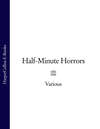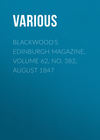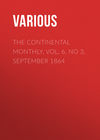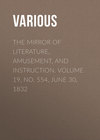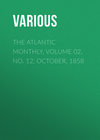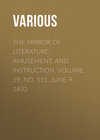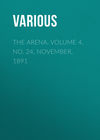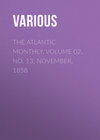Loe raamatut: «The Mirror of Literature, Amusement, and Instruction. Volume 13, No. 356, February 14, 1829», lehekülg 4
Mille et Quingentos postquam compleverit Orbis
Tuq: et ter demos per sua signi Deus
Prima sauluteferi post cunabula Christi,
Cui datur omnium Honor, Gloria, Laus, et Amor.
The principal window is particularly admired as a rich specimen of Gothic beauty, and a tourist, in 1818, says, "bids defiance to time and tempest;" but in our engraving, which is of very recent date, the details of the window will be sought for in vain. "Shrubs and trees," observes the same writer, "have found a footing in the crevices, and branches from the walls shook in undulating monotony, and with a gloomy and spiritual murmur, that spoke to the ear of time and events gone by, and lost in oblivion and dilapidation. At the end, immediately beneath the colossal window, grows an alder of considerable luxuriance, which, added to the situation of every other object, brought Mr. Southey's pathetic ballad of 'Mary the Maid of the Inn,' so forcibly before my imagination,5 that I involuntarily turned my eye to search for the grave, where the murderers concealed their victim." He likewise tells us of "the former garden of the monastery, still cultivated, and exhibiting a fruitful appearance;" cells and cavities covered with underwood; and his ascent to a gallery by a winding turret stair, whence, says he, "the monks of Kirkstall feasted their eyes with all that was charming in nature. It is said," adds he, "that a subterraneous passage existed from hence to Eshelt Hall, a distance of some miles, and that the entrance is yet traced."
THE NATURALIST
AMERICAN SONG BIRDS
The Mocking-bird seems to be the prince of all song birds, being altogether unrivalled in the extent and variety of his vocal powers; and, besides the fulness and melody of his original notes, he has the faculty of imitating the notes of all other birds, from the humming-bird to the eagle. Pennant tells us that he heard a caged one, in England, imitate the mewing of a cat and the creaking of a sign in high winds. The Hon. Daines Barrington says, his pipe comes nearest to the nightingale, of any bird he ever heard. The description, however, given by Wilson, in his own inimitable manner, as far excels Pennant and Barrington as the bird excels his fellow-songsters. Wilson tells that the ease, elegance and rapidity of his movements, the animation of his eye, and the intelligence he displays in listening and laying up lessons, mark the peculiarity of his genius. His voice is full, strong, and musical, and capable of almost every modulation, from the clear mellow tones of the wood thrush to the savage scream of the bald eagle. In measure and accents he faithfully follows his originals, while in force and sweetness of expression he greatly improves upon them. In his native woods, upon a dewy morning, his song rises above every competitor, for the others seem merely as inferior accompaniments. His own notes are bold and full, and varied seemingly beyond all limits. They consist of short expressions of two, three, or at most five or six, syllables, generally expressed with great emphasis and rapidity, and continued with undiminished ardour, for half an hour or an hour at a time. While singing, he expands his wings and his tail, glistening with white, keeping time to his own music, and the buoyant gaiety of his action is no less fascinating than his song. He sweeps round with enthusiastic ecstasy, he mounts and descends as his song swells or dies away; he bounds aloft, as Bartram says, with the celerity of an arrow, as if to recover or recall his very soul, expired in the last elevated strain. A bystander might suppose that the whole feathered tribes had assembled together on a trial of skill; each striving to produce his utmost effect, so perfect are his imitations. He often deceives the sportsman, and even birds themselves are sometimes imposed upon by this admirable mimic. In confinement he loses little of the power or energy of his song. He whistles for the dog; Cæsar starts up, wags his tail, and runs to meet his master. He cries like a hurt chicken, and the hen hurries about, with feathers on end, to protect her injured brood. He repeats the tune taught him, though it be of considerable length, with great accuracy. He runs over the notes of the canary, and of the red bird, with such superior execution and effect, that the mortified songsters confess his triumph by their silence. His fondness for variety, some suppose to injure his song. His imitations of the brown thrush is often interrupted by the crowing of cocks; and his exquisite warblings after the blue bird, are mingled with the screaming of swallows, or the cackling of hens. During moonlight, both in the wild and tame state, he sings the whole night long. The hunters, in their night excursions, know that the moon is rising the instant they begin to hear his delightful solo. After Shakspeare, Barrington attributes in part the exquisiteness of the nightingale's song to the silence of the night; but if so, what are we to think of the bird which in the open glare of day, overpowers and often silences all competition? His natural notes partake of a character similar to those of the brown thrush, but they are more sweet, more expressive, more varied, and uttered with greater rapidity.
The Yellow breasted Chat naturally follows his superior in the art of mimicry. When his haunt is approached, he scolds the passenger in a great variety of odd and uncouth monosyllables, difficult to describe, but easily imitated so as to deceive the bird himself, and draw him after you to a good distance. At first are heard short notes like the whistling of a duck's wings, beginning loud and rapid, and becoming lower and slower, till they end in detached notes. There succeeds something like the barking of young puppies, followed by a variety of guttural sounds, and ending like the mewing of a cat, but much hoarser.
The song of the Baltimore Oriole is little less remarkable than his fine appearance, and the ingenuity with which he builds his nest. His notes consist of a clear mellow whistle, repeated at short intervals as he gleams among the branches. There is in it a certain wild plaintiveness and naïveté extremely interesting. It is not uttered with rapidity, but with the pleasing tranquillity of a careless ploughboy, whistling for amusement. Since the streets of some of the American towns have been planted with Lombardy poplars, the orioles are constant visiters, chanting their native "wood notes wild," amid the din of coaches, wheelbarrows, and sometimes within a few yards of a bawling oysterwoman.
The Virginian Nightingale, Red Bird, or Cardinal Grosbeak, has great clearness, variety, and melody in his notes, many of which resemble the higher notes of a fife, and are nearly as loud. He sings from March till September, and begins early in the dawn, and repeating a favourite stanza twenty or thirty times successively, and often for a whole morning together, till, like a good story too frequently repeated, it becomes quite tiresome. He is very sprightly, and full of vivacity; yet his notes are much inferior to those of the wood, or even of the brown thrush.
The whole song of the Black-throated Bunting consists of five, or rather two, notes; the first repeated twice and very slowly, the third thrice and rapidly, resembling chip, chip, che-che-che; of which ditty he is by no means parsimonious, but will continue it for hours successively. His manners are much like those of the European yellow-hammer, sitting, while he sings, on palings and low bushes.
The song of the Rice Bird is highly musical. Mounting and hovering on the wing, at a small height above the ground, he chants out a jingling melody of varied notes, as if half a dozen birds were singing together. Some idea may be formed of it, by striking the high keys of a piano-forte singly and quickly, making as many contrasts as possible, of high and low notes. Many of the tones are delightful, but the ear can with difficulty separate them. The general effect of the whole is good; and when ten or twelve are singing on the same tree, the concert is singularly pleasing.
The Red-eyed Flycatcher has a loud, lively, and energetic song, which is continued sometimes for an hour without intermission. The notes are, in short emphatic bars of two, three, or four syllables. On listening to this bird, in his full ardour of song, it requires but little imagination to fancy you hear the words "Tom Kelly! whip! Tom Kelly!'" very distinctly; and hence Tom Kelly is the name given to the bird in the West Indies.
The Crested Titmouse possesses a remarkable variety in the tones of its voice, at one time not louder than the squeaking of a mouse, and in a moment after whistling aloud and clearly, as if calling a dog, and continuing this dog-call through the woods for half an hour at a time.
The Red-breasted Blue Bird has a soft, agreeable, and often repeated warble, uttered with opening and quivering wings. In his courtship he uses the tenderest expressions, and caresses his mate by sitting close by her, and singing his most endearing warblings. If a rival appears, he attacks him with fury, and having driven him away, returns to pour out a song of triumph. In autumn his song changes to a simple plaintive note, which is heard in open weather all winter, though in severe weather the bird is never to be seen.—Mag. Nat. Hist.











